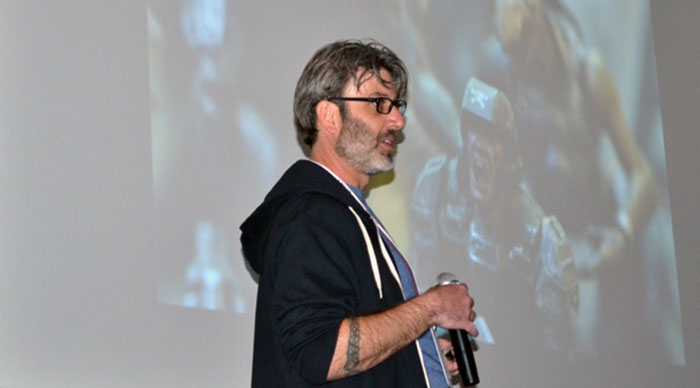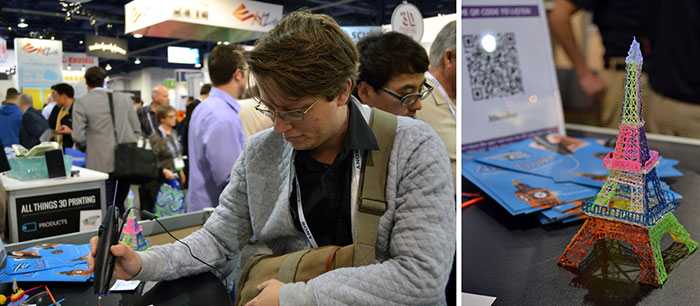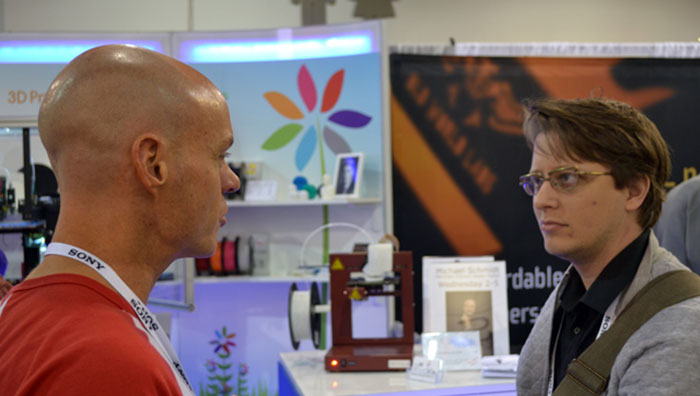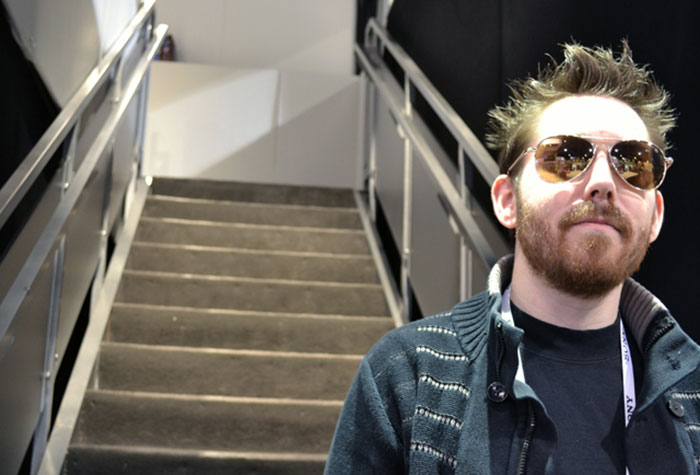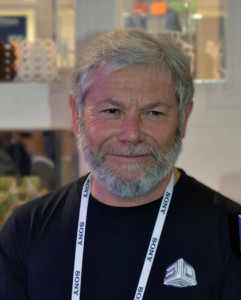
My wife and I rushed over to the convention to catch “Don’t Believe the Hype? 3D Printing Uncovered”. It touched a nerve as the hype (or otherwise) of 3D printing was pulling them to the conference track in droves. The bats had swarmed the place. I was numb to them and only wanted to see Avi Reichental, CEO of 3D Systems, talk 3D Printing 2.0. He preached familiar passages from the 3DS bible, saying, “With 3D printing, complexity is free.” 3D Systems turned the word “easy” into a noun, that magical state of mind in which the power of 3D printing is at our greasy fingertips without effort, issue or thought. The new Cube is the road to “get us to easy,” with insta-load filament cartridges and a wireless connection for under $1k. If TCT+Personalize wanted to downplay the hype, Avi wasn’t really helping at this point.
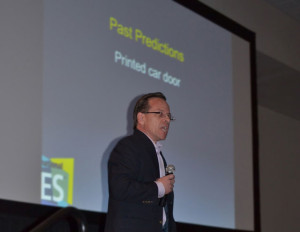
Just then, Jason Lopes stormed in with the idealism that I’d come to love about the 3D printing hype, as espoused by 3D printer users themselves. Sure, there are snags in the tech, obstacles to overcome, but when you see what Legacy Effects has done with the technology, starting back in 1998 with the opening sequence of Small Soldiers, you instantly become a believer again. Lopes brought an excitement and vitality to the stage that teaches you to temper your realism with delusions of grandeur. Legacy didn’t begin with in-house machines, but, by the time they were printing Iron Man helmets and Halo figurines, they started filling their workshop with machines like Connex, Eden, EnvisionTec and Fortus. They even had a Replicator 2, given to them as a gift. The MakerBot 3D printed Jason some chin clips for Captain America at the edge of a deadline, proving that the lower-end machines can be great in a crunch.
Legacy Effects has transformed the special effects department from a post-production component of filmmaking to something that informs the filmmaking process. They’ve created Arduino-controlled electronics, props that actually interact with the set, as seen in Pacific Rim. When Lopes showed us a pair of 3D printed, fully articulated gloves with resolution so fine that you’d think they were carved by artisans who’d passed their skills down carefully generation after generation, I knew that I must have been getting into the veggie trip deep. “What was in that wrap?” I wondered. The man’s PowerPoint continued to flash a series of images of things that I wasn’t sure could actually exist. And second by second, I thought that I was starting to lose my grip on the world around me. “Was this real?” Danielle, who had started to believe that she and the camera had formed a symbiotic relationship and kept the camera fixed to her face at all times to see things “more clearly”, turned to me and asked, “What?”
Before I could take a moment to collect my thoughts, Alan Guyan from Under Armour walked gallantly onto the stage and continued to push the boundaries of the conceptual framework I used to hold my reality together. The company, for which he is Technical Design Manager, makes 3D printed active-wear. “That’s simple enough,” I thought. When he began to explain that they’d 3D printed the casing for a heart rate monitor, a halter that wraps around your torso and measures your body’s reaction to physical activity, I could sense the ground begin to shift. “Armour 39 even tracks your will power,” Guyan said. “Tracks your what?” I asked my wife. “Your will,” she whispered in awe. The young entrepreneur went on to say something about how many reps you can do, how the halter will measure those and track your ability to push past your previous record. Your will power. Your ability to control your self. What was my will? An ad began to play, showing human creatures that had swallowed the workout pill and could push their bodies further and further everyday, thanks to the device. “It will send your information to your phone or smart watch so that you can obsess over your will power and think about it every day,” it said. Those creatures in the ad – had they improved their ability to control themselves or merely given it away to someone – or something – else? Did they even have will to give away in the first place?
“We’ve got to get out of here,” I said. Danielle turned with the camera fixed to her face, hair astray and sweat dripping down her forehead. She bobbed her head and camera up and down in the affirmative. I picked up my bag and we stumbled out of the conference room and barreled towards the exhibition hall, hoping that it would be cooler, less strange in there. “Ok, so what else should we see? Something a lot less creepy.” We wobbled over to the 3Doodler.
Some called it pure genius. Others called it a glorified glue gun. I’m one of the former and, seeing it in person reaffirmed my beliefs. It was extremely easy to use. Faraz Warsi, Lead Interactive Designer & Chief Doodler, guided us in dragging strings of PLA from a point on a piece of paper and into the air. “Stop there and hold it for a few seconds to let it cool.” And the plastic just froze. “PLA works better on surfaces like paper,” the Chief Doodler began to say when I grabbed him by the collar, “Do you understand what this means, man? Kids. The inept. Beasts like me! Anyone can use this thing. Do you get it?”
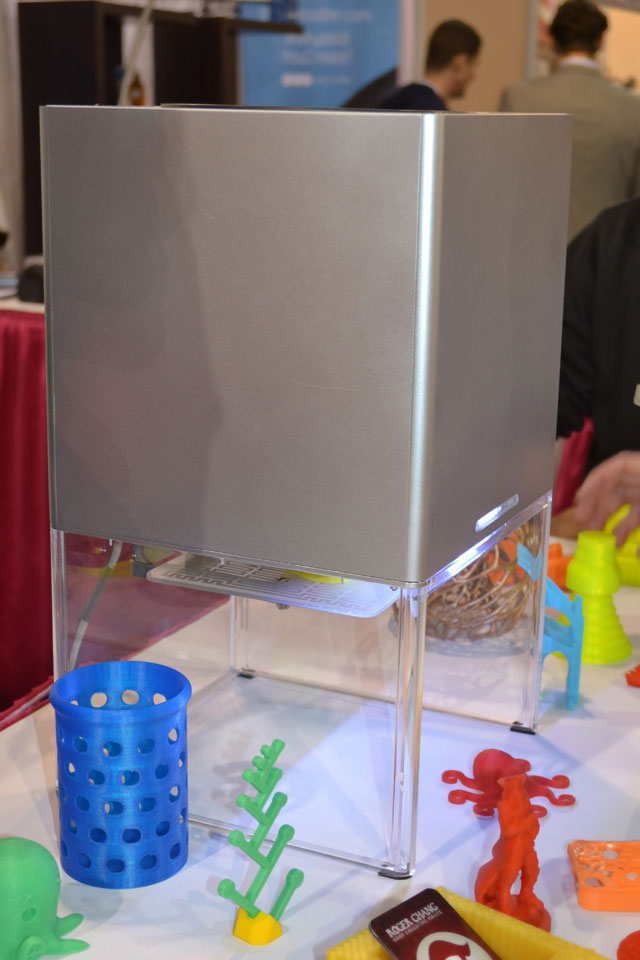
The temperature in the building was steadily increasing. As we meandered over to the Pirate3D booth, the thought returned, “Do I have a will? Or does a will have me?” I tried to avoid the existential downward spiral beckoning me from the depths of my unconscious by introducing myself to Roger Chang. “Oh! 3D Printing Industry,” he said. “How’s it coming along, Roger?” I asked. The makers of the Buccaneer 3D Printer, an FFF machine being sold at a price so low – $349 – that no one could believe it existed, told me that they were itching to get back to Singapore to continue getting their Kickstarter orders out to their backers. Their backers had become violent, as of late, attacking the project’s comment boards because Pirate3D decided to remove ABS support. “I can understand that, Roger, my friend. What do you make of those people mad about the ABS support?” Roger told me: “We removed the heated bed, actually, for very important reasons. When I was using the Buccaneer, running ABS one day, the fumes started to get to me. I didn’t realize what it was for a moment and then, suddenly, it hit me. This ABS is making me feel sick!” Sick. I knew what that was like. It was getting hot in the convention center and in between my skin and bones. “So, we decided not to support ABS. We want this to be a machine that people can use on their desktops, without ventilation ducts. And, with ABS, that’s just not possible. As for the lack of auto-calibration that people were mad about. We never promised that in the first place.” Roger went on to say that, hopefully in May or so, after fulfilling their Kickstarter orders, they’d be selling the Buccaneer to retailers. Because retailers take a slice off the top, the price likely wouldn’t be as low as it had been on the crowdfunding platform.
Speaking of retailers, Danielle and I headed over to our favorite retailers at 3DPrintLife, Jeff Stevens and Joel Rush. They even had a new person to introduce to us, Buzz Baldwin – of no relation to the Baldwin Brothers or the Buzz Aldrens. Jeff began showing us around, introducing us to the items they were selling in their Shapeways store, which included some luchadores, Mexican wrestlers, designed by an art student in the Netherlands. Jeff explained that they wanted to give students an opportunity to sell their wares and get into the design business through 3D printing and had plans to incorporate amateur and professional designers in their store, as well. He went on to show us little labels they’d placed throughout their booth, indicating the printing time of each piece, as well as the amount of filament required and the total material cost of the individual items. This small gesture represented the company’s philosophy as a whole, to educate people and make 3D printing accessible. The 3DPrintLife team then introduced us to Karl from Hyrel and told us that they’d be selling Hyrel machines on 3DPrintLife. These machines, with their huge range of materials and interchangeable print heads, could be perfect for design students and other professionals. Karl even hinted to me that they’d have some big surprises involving the use of a laser in the near future. It was halfway through his demonstration of how the machines had Windows 8 built into their system, so that you could do stuff like check your Facebook while printing an object, that I started to feel faint. “Mike, are you alright?” Jeff asked. “Is it hot in here or is it just me?” I asked. “Is it just me?” I repeated. Danielle peered at me with her camera face, the lens angled with a note of concern.
“Honey?” I asked. “Is it hot in here?” “Unbelievably so,” she replied. We pushed our way towards the bathroom, swatting bats away with our hands and shielding our eyes. I found myself in front of the mirror in there, splashing water onto my face and looking at something I didn’t recognize. What is a will? Is it even something you have or is it just something you are? Am I will?
That was the answer. We fell out of the restroom and at each other, looking into one another’s eyes with full realization. Simultaneously, we spoke, “Will. I. Am.” The musician was going to be doing a press announcement with 3D Systems, but our flight was leaving before we’d get a chance to see Avi doing the worm with will.i.am. We were desperate, having found truth and not wanting to let go. Breaking back into the exhibition hall, Danielle and I were laser guided towards the 3D Systems booth, a two story structure flanked on either side by different types of printers. We made our way up to the stairs that led to the top level, greeted by a young man wearing a bandana and sunglasses, standing behind a velvet rope. On our knees, we read the badge, “Adam Reichental.” “Adam. Listen carefully. We need to speak to Avi and will.i.am.” “I’m sorry. Avi’s in a meeting,” the CEO’s son replied and, seeing the desperation in our wide-pupils, “Give me your card and maybe we can schedule an interview for sometime in the next couple of days.”
“We don’t have a couple of days, Adam. This needs to happen now. Right now.”
The young bouncer thought carefully, “I can’t get you up to see him, but I might have something for you.” He led us over to the ChefJet Pro 3D printer, where a gaggle of beasts had swarmed the sugar printer, feasting their eyes on coloured candy printed layer by layer. Adam burrowed through to the front like he “knew a guy” and grabbed us bits of psychadelic rock printed into tiny elaborate shapes. “Here,” he said, “take these.” He’d grabbed himself one, too. “They’re sour apple.” “Sour apple?” I asked. “But you can colour them whatever you want,” he continued. We slapped the pixie cups of printed sugar together, with Adam saying, “L’chaim.” Yeah. To life. Whatever it is. Then, the rocks hit our tongues and began to dissolve.
“Things are going to get really sour in 3…2…1,” Adam said, pointing into the air, as if to command time in memoriam. And he was right. The room spun with the Earth’s rotation and all around us we heard the conventioneers in conversation:
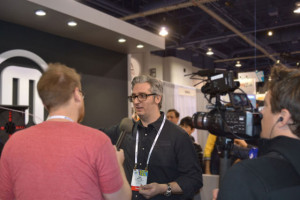
“Danni,” I said to my wife, “I think we have to go before we miss our plane.” She responded, “We have to go before it’s too late.” Business cards started invading our perceptual space from all sides. We struggled towards the exit. We found a door labeled, “Please use other entrance.” We walked several yards down the hall to the next. Again, it read, “Please use other entrance.” So, we continued on down the hall, surprised with a door and a sign that read, “Please use other entrance.”
“What other entrance?” I shouted. A muscular Eastern Eurpoean with a black shirt that read “STAFF” came over and said, “Here, let me help you.” He led us through an open room, which we traversed for some time until we reached an exit. We thanked him graciously and Danielle shoved a wad of business cards into his pocket. “Keep the change,” I said. Before we could exit the empty room, however, an elderly woman approached us and asked, “Have you been accessed, sir?” I responded, “What?” She repeated, “Have you been accessed?”
“What do you mean ‘accessed’?” She held out a small, mechanical device that whirred and beeped. “Let me scan you.”
“Get away from me with that thing,” I pulled away. “It’s just an iPhone, sir. It needs to access you.” It was too late to retreat, she had already accessed me, placing the device on my ID badge and pressing a button. The device devoured my data through little black lines on the badge, “Granted,” it burped in a genial accent. At that, my wife grabbed me by the wrist and pulled me downstairs where we swam over an ocean of conventioneers. Just before we were consumed in CES fire, we pushed through the exit doors and were hit with a cool gust of wind, washing the convention from our psyches in one swoop.
Clear. As we got into the cab to head back to the sane city of Los Angeles, the realization slowly dawned. Danielle turned to me, locked into the same thought, “No veggie wrap is that powerful. All of that. That was CES.”
[nggallery id=134]

